Vol 3 - August / September 1996
Jennys plea for the database ... Please could you all take some time to photocopy and post your dogs family tree to me .. So far I have approximately 360 dogs in my database but many are from overseas (yes I want them too) and there are still hundreds in NZ I haven't got.
We are privileged to have permission to reprint the following article written by Marion Coffman. TYPE AND THE BREEDER'S RESPONSIBILITYType is what makes a Vizsla look like a Vizsla. Breed type is an absolute requirement for breeding, showing and judging. The best way to effectively preserve breed type is to aim for breed type in your breeding program, select for it in the whelping box and restrict yourself to showing only those Vizslas of correct type to judges who know and appreciate correct type.Having a good idea of anatomy, including bones and muscles will make it easier to read and understand the standard for our breed. Keep in mind also, that type is meaningless if it does not include soundness.
Photo: Ch. Maggy Mae of Szep-Allat (Maggy) Style is the achievement of successful longÄterm breeding and defines a breeder's specific interpretation of the standard. Vizslas of the same general appearance certainly differ in their STYLE, but are within the limits of our breed TYPE. A breeder decides what combination of characteristics he or she finds correct in terms of what he or she believes the breed standard means and breeds accordingly, since a standard does allow for some individual interpretation and preference.A good head is essential for true type, but here is where a breeder sets his or her stamp and it is enviable when a breeder can consistently produce his or her ideal style, even if we don't personally agree with that ideal. No mater what we feel is correct, we can all appreciate that kennel whose dogs can be identified by their type alone. But no matter how beautiful a dog or how close it fits the standard, an unsound dog, either physically, mentally, or genetically, must never be considered correct in type, as no standard calls for unsoundness. A breeder must learn what type of Vizsla he or she can not accept, things he or she can not live with because that instinctively offend his or her sense of order. Don't change goals as you go along to reflect current fads. Whether a breeder or exhibitor, next time you are ringside watching any Vizsla judging, look for the presence of virtue, look for some style and class, something that exudes breed type plus that certain "something" that makes a Vizsla different than other sporting breeds. It is probably not even a part of the standard, but it is sure to be a subtle difference, and you are finally beginning to really see how type and style blend together. Breed TYPE should be a priority for every breeder. Consistent STYLE should be the goal. This article was written by Marion Coffman, Author, Versatile Vizsla, Alpine Publications. If you are interested, her book can be purchased directly from the publisher, Alpine Publication, Loveland, Colorado USA. They have an 800 phone number. ( 800 ) 777-7257. Where are we goingby Leah McDonald
Keita and Leah are part of the McDonald family (Debbie, Keith & Leah McDonald and Abody Aniko of Debrecan (Keita)) from Dunedin and they also sent some lovely photos featured in this issue as well as the wonderful bathroom scene photo shown in the last issue. "COMPANY'S COMING"Husband's putting on a tieThe kitchen smells of apple pie Floors are polished, tables glow Records playing soft and low Six o'clock and all is well At last I hear the front doorbell Pat my hair and check my face Not an ashtray out of place Then a voice speaks loud and clear "MOM, THE DOG THREW UP IN HERE!" Author Unknown The Cost of our Best FriendBy Craig & Julie BennetOur pooch, Jed (Ryan of Szep-Allat), was bought from Jan Edwards after two trips from the Manawatu to Featherstone. Expense number two was the kennel and not just any kennel but one of igloo design so that he could show it off when he had guests over. Third expense was miscellaneous clothing, plants and sundry outdoor equipment i.e. screen door, designed especially for puppy teeth. It was about this time that Jed s exuberance for movement in the car and requirement for all round visibility meant that we had to buy him a 4WD. All was quiet on the expense front until we shifted from the Manawatu, with employee housing, to Wellington, without employee housing. The rental market in Wellington did not have the essentials on Jeds check list, like: high fencing; parks; a river; and close proximity to the bush. So we bought him a house in Upper Hutt to match his requirements and since moving in have thrown in a garden hose, a leash, cat door and back door mat all to chew on. To all of the above we added, add food, vet bills, canine accoutrements, several lives off the cat, petrol and lots and lots of time. The total bill for Jed s first thirteen months exceeds $148,000 - that s a charge out rate in excess of $15.00/Hr. For that we get undying devotion, many smiles, a super clean kitchen floor, a super dirty back door step, plants pruned, irrigation channels dug, daily exercise, canine processed food mounds all over the back yard, slobber on our clothes, an immovable lump in front of the fire and a head between our knees everywhere we walk around the house. So the question that must be asked is Is it worth it? You bet it is, we want another one in another year or so!
Question: What's the difference
between a Vizsla and a wife? Thanks Craig and Julie! TUX WONDER DOGS
Again this year's Tux Wonder Dogs will feature a team of Vizslak - the Hungry Hounds (the name was picked by TVNZ). This years team comprised of:
The TV crew was wonderful as were the other competitors. We had a great time helped by the fact that a small lake at the filming grounds gave our guys a wonderful chance to frolic and enjoy themselves during times that they were not competing. I'm not going to spoil it for you by giving you any results at this stage (maybe a short critique AFTER it has shown on TV) but have included some photos of the weekend showing our highly energetic dogs.
The Wonder Dogs team (Dexterity Productions) are also producing a book on dog breeds in New Zealand. At every Tux Wonder Dogs that has had a Vizsla team, they have stolen the hearts of the production team so naturally they approached us to see if we would contribute an article to them about the best breed in the world. So keep an eye out for the release of this book just before Xmas. Make Your Own Cool-MatsThanks to the "Cleanrun Agility List"This wonderful idea, showing how to make a cool mat for your dog a cooling neck scarf for yourself, could be a life saver on hot days at breed shows, agility events, field trials or even a day out at the beach or in the bush: Go to your plant nursery and get a package of Polymer Granules, it will probably have a brand name. It has a fantastic adsorption rate--1 pound of the granules will hold 50 gallons of pure water, much less if high in minerals or salts. Lay out the size mat you think you'll want, top and bottom pieces, sew around three sides, sew parallel tubes about 1 1/2 inches wide. Put about 1 teaspoon of the granules per 12 inches of length of each tube. Sew across the 4th side. Place it in water, about 30 minutes will give you 1/2 absorption, 60-90 minutes should give 100% saturation. If you find its too full or not full enough, leave it dry completely out Äseveral days and add or take out granules as you see the need. Take an ordinary scarf to make a cool collar for yourself. Any granules you don't use this way you can mix in with your soil for your plants as per the original instructions that came with the stuff from the nursery Ä you won't have to water your plants the whole time your are off to the next dog competition. ADDING A NEW HUMAN TO YOUR VIZSLA HOUSEHOLDBy Steve PeacockeThere are several very good books and articles for getting a new human when you have a young Vizsla in the house. Here are just a few of the examples of things to watch out for: Make certain that you crate your new human and that it learns to sleep in that crate and that the crate (or kennel) is always accessible as a place it can go for peace. Always ensure that you keep an eye on the human every time that it gets near your Vizsla as your human can interpret signs differently from the Vizsla and the human instinct may come through - you wouldn't want to have your human biting your Vizsla and having to put your wonderful new human down now would you? Teething times can be destructive, several people on the Internet Vizsla list have mentioned pig's ears as being quite effective (it may pay to ensure that the pig part is removed before giving your human one of these). You can get wonderful cages to place in the back of your car to place your human when travelling so that it doesn't interfere with your Vizsla, if you leave your human in your car make certain that it is only for a short while (eg; just getting milk from the store), and that you leave a little space at the top of the windows to let fresh air into the car so your human won't be unduly stressed. Little humans can often be so cute that they tend to attract the attention of passers-by so you may come back to your car to find it surrounded by people who will ask you all about the breed and perhaps even the breeding line, and if you will be having any babies from it in the future. Remember to ensure that you watch your new human for the first few years as they tend to have difficulty with house training so take it out on the lawn often. Take your pooper scooper with you when going for walks so you can watch out for human-doo. Human obedience classes are a must as is socialisation at an early age. Let it know who's boss without resorting to anger, and make sure that you get it used to the collar. Please check the local bylaws in your area regarding new humans, some areas, for instance, do not allow a human in parks unless they are on a lead and not on beaches at all. The Rainbow BridgeDedicated to NZ Ch Agasvari Draga Zephir who was tragically run over in June and to all those other special friends you all have lost.Just this side of Heaven is a place called The Rainbow Bridge. When an animal dies that has been especially close to someone here, that pet goes to Rainbow Bridge. There are meadows and hills for all of our special friends so they can run and play together. There is plenty of food, water and sunshine and our friends are warm and comfortable. All the animals who had been ill and old are restored to health and vigour; those who were hurt or maimed are made whole and strong again, just as we remember them in our dreams of days and times gone by. The animals are happy and content, except for one small thing: they each miss someone very special, someone who was left behind. They all run and play together, but the day comes when one suddenly stops and looks into the distance. His bright eyes are intent; his eager body begins to quiver. Suddenly, he breaks from the group, flying over the green grass, faster and faster. You have been spotted, and when you and your special friend finally meet, you cling together in joyous reunion, never to be parted again. The happy kisses rain upon your face; your hands again caress the beloved head, and you look once more into those trusting eyes, so long gone from your life, but never absent from your heart. Then you cross the Rainbow Bridge together...
REZSULTS
New champions since last issue are: Ch Ruby Roze of Szep-Allat and Ch Ripp of Szep-Allat. Both of these beautiful dogs are owned by Jan Edwards - congratulations Jan. Well quite a number of Vizslak are starting to make their mark in agility (although unfortunately Spud isn t one of them yet!). Judy Young and Anne McMasters s dog NZ Ch Agasvari Gyongy Virag (Cheska) attained an AD - well done Cheska! Julian Stephens' dog, Wynyard Lord Szylow was first in Intermediate I, Intermediate 3 and Senior I courses at Wairarapa and second in Intermediate 2 - a very good weekend - well done Julian. And then in June he went on to take 1st place in Senior at the North Taranaki Canine Obedience Club. Sue & Rob McKee's dog Ochre (Abody Ochre of Debrecan) who was featured last newsletter had a respectable 2nd in both Starters and Novice at Blenheim and their GSP, Kura, was first in the Intermediate at Blenheim and first in senior at Nelson. Robert Dodunski's dog, Szerda of Brookbury (Mika) was placed first in the Pointer and Setter section of the Seddon Gundog Society's Field Trials. Breed shows have been having a quieter time but our Spud (Ch Jovita of Szep-Allat) was best of Breed at the Hamilton Kennel Associations big show at Claudelands in July. Congratulations to everyone who has had success with their dogs in any field they try! Don't forget to let us know what your dog is doing! If you don't tell me us, we often have difficulty finding out. And we don t just want to know about the more formal events. We'd love to know which dog found it's first deer! Or be told about the record breaking weekend when the dog missed more birds than ever before! Or hear about the dog that passed the puppy, Introductory, advanced (whichever) class in their local obedience club! LET US KNOW WHAT YOUR VIZSLA IS DOING!!!!
A New Zealand FIRST!The sire is American Dual Ch. Behi Red Chief and the Dam is Ch. Huburtus Claim To Fame Imp. Australia - whelped on 21st July 1996 - 3 bitches and 4 dogs. Chief is bred by B.C. and H.R. Boggs and is proudly owned by Randy and Sue Boggs. B.C. Boggs may be a familiar name to some - he is the author of the book "The Vizsla". Chief is the third generation of Dual Champions. Sue Boggs wrote "Chief s puppies seem to have this bird crazy 'let me at em' attitude about them!" Fame, the Dam, has really lived up to her name by taking reserve gundog at last years Pal National dog show out of an entry of 450 gundogs. The judge was Mrs A. Billings from U.S.A. Fame is also the Dam of Szep-Allat's most recent champions, Ch. Ruby Roze of Szep-Allat and Ch. Ripp of Szep-Allat. Both are Group and In Show winners. Both show an excellent attitude to field work. THE GET TOGETHER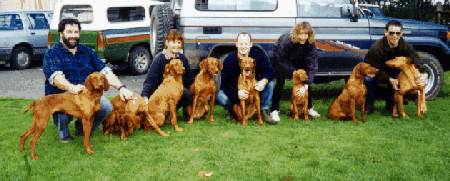 Left to Right: Steve Peacocke with Maggy & Spud;Sharon Gillespie with Tessa & Kez; Warrick Gibbs with Hydro; Michelle Hawthorne with Rusty; Aaron Hansen with Briar & Kovac. Vizslak - Bet you can't have just one!
For those on the Internet Check out these sites:Web note: Some addresses may be out of date since this newzsletter was publishedFor this reason addresses are not auto-linked reader's are advised to use the links from the Links Page Ingle & Mead Vizsla Home Pages - http://users.aimnet.com/~imc/ Planet Vizsla - http://www.oz.net/~praxis/vizsla/Hasta.htm Poquito Vizslas - http://204.134.124.1:80/poquito International dog-related web sites - http://www.zmall.com/pet_talk/pet-faqs/dog-faqs/lists/www-list.html The Dogpatch - http://www.tomco.net/~toshntaz/ Kahoos K-9 Line - http://www.harborside.com/kahoos All are well worth visiting and have some wonderful photos of Vizslak! CLICKER TRAININGI hope that the following series of articles (3 in all - 1 this issue and another in each of the next two issues) are as interesting to you as I found them.Using a ClickerThere are many advantages to using a clicker as a secondary reinforcer, rather than using a primary reinforcer while you are training. The biggest, is that it is an instantaneous cue to the dog that he is performing the right action. When using traditional reinforcers, there is often a time lag. For example, by the time you get the phrase "good dog" out, your dog could have gone from a correct action to an incorrect action, and you are praising the wrong thing.Another example, is that by using the clicker, we separate the primary reinforcer from the exercise. Food tends to focus the dog on the food, not the handler or exercise, and the same goes for toys. First, you have to teach your dog that the secondary reinforcer, is a secondary reinforcement. In other words, you have to teach him that the clicker is always followed by a reward. This reward should be meaningful. For example, for Quest, at first food wasn't a reward, she didn't want it. She did however, want to play tug, so I used that. Teaching this, is very easy. Sit down somewhere comfortable with a clicker and your primary reinforcer. I'm going to use food as an example. When the dog comes up to get a piece of food, click as you are giving the food. You'll do this several times, at the same instant the dog is getting the food, you'll click. As the dog gets into it, you can start separating the time between the click and the food. Click should always come first, than food. Randomize the time lag - sometimes almost immediately, other times even one or two minutes away. You want to be able to reward your dog while he is doing something, and then walk over and get the food. You're looking for a light bulb to come on in the dog's head. When he hears the click, he should stop what he is doing and be ready for the reward. By the way, you don't really have to use a clicker. You can use a whistle, cluck your tongue, or even snap your fingers when the dog has performed a correct action. It should be a quick, short noise that can be reproduced. You also want something than can be heard from across the ring. Next issue 'Using Clickers in Obedience' Copyright 1995 by Kathleen Weaver kathleen@metronet.com Reprinted with authors permission and thanks to the clicker association. COOKING WHAT YOU HUNT WITH YOUR DOGSROAST DEERServes 12
Clean, wash and wipe meat with a cloth. Leave in a single piece or cut into servingÄsize pieces. Rub with salt, white pepper, ginger, sugar and celery salt in generous amounts. Brown the meat in hot olive oil in a roasting pan on top of the stove or under the broiler. Turn to brown well on all sides. Add the remaining ingredients except the cream, eggs and jelly. Cover and roast slowly in an oven preheated to 300 degrees for 3 hours. Turn every 15 or 20 minutes. Do not pierce the meat. When done, place on a hot plate and return to oven to keep warm. Pour the cream into the roasting pan, mix well with juices. Boil about 10 minutes, stirring often. Stir in the beaten egg yolks and the jelly, stirring until mixture thickens. Do not boil. Beat the egg whites until stiff and fold into the gravy. Bon Appetite ....
A Vizsla that Won't Jump Up!by Robyn Fowkes, Cootamundra, NSW This was originally written as a response to the question "How do you train a Vizsla not to jump up?" in the newsletter of The Vizsla Club of NSW.
To use my dog, Vincent, as an example he has two options:
The first task of behaviour management is to work out how to get your dog to understand what it is you want. If you think about this enough you can usually work it out. If not, ask someone else for ideas. It s also important to understand what needs and instincts have been bred into your dog. Work with these, not against them. The next principle in behaviour management is to reward successive approximations. That is, if your dog gives any indication of doing what you want, reward him effusively. Tell him how wonderful he is, give him a pat, sound happy and excited that he's been so good. Your dog wants you to be happy with him so as soon as he works out what pleased you he'll do it again. Reward him again! Keep it positive. Don't wait till he has mastered the whole behaviour perfectly. He won't understand what you re trying to achieve and he won't be motivated to achieve it. You have to teach him and encourage him. His motivation is you being happy. If your dog does what you don't want, simply say no in a firm or strong voice (you don t have to yell) and ignore him or walk away. If he comes back again, repeat the procedure. If "no" isn t working, put him away for a short time (5 minutes will do), he'll soon work it out. Do not punish him. Punishment or negative reinforcement will only delay your training. You will have to take time to overcome his fear and then you'll still have to train him. The next three principles in behaviour management are that you have to be: INSISTENTPERSISTENT andCONSISTENT.By insistent I mean that you have to insist that your dog cannot jump up. Hold him down against your legs and pat him or rub him under the chin. Let him know that very definitely he cannot jump up. Be persistent. Your Vizsla will be persistent, so you have to be even more persistent. Don't try it two or three times and give up. It takes at least three weeks to establish a behaviour as habit and even after this there will be occasional lapses. Keep teaching him the acceptable behaviour. Finally, you have to be consistent. You have to insist on the acceptable behaviour every time. It's not OK to jump up on you because you ve got your old gardening clothes on. He's not allowed to jump up any time. You go through the same procedure every time. He will eventually get the message. It is important to believe in your dog and trust him. He can learn and he will learn. He loves you and he wants you to be pleased with him. You only have to teach him what it is you want. Take time to teach your dog and keep it a positive experience. Robyn is a psychologist with a three year old Vizsla dog, Ch Hanafor Master Vincents ET. The ET is his endurance title.
 Return to the Home Page Return to the Home Page
This Vizsla newsletter is hosted on the Web by The Computer Suite
Limited |

 Correct type first is evident in looking at the dog in profile and studying
balance and profile. A lovely longer neck sloping smoothly to the withers and
a longer back give you an idea of balance and proportion. That same longer
neck would look out of place on a short backed dog. Compare the total body
length to total size, or height of the dog. Does it look balanced? Is the
topline correct, or does it sag or roach? Is there a slight rise over the
croup with the tail set slightly lower than the back or is the tail coming
off the topline? A "good eye" for a dog is what we need to develop
and learn. Try to translate aesthetic language into breeding terms as you
look at line, balance, form, and flow. The problem that arises is that
everyone seems to have his or her own idea of what proper type really is.
Depending on who you learn from, or what strikes your eye as attractive, you
may fall into the ranks of supporters of one type or another. There are as
many ways of interpreting the standard as there are breeders and
exhibitors.
Correct type first is evident in looking at the dog in profile and studying
balance and profile. A lovely longer neck sloping smoothly to the withers and
a longer back give you an idea of balance and proportion. That same longer
neck would look out of place on a short backed dog. Compare the total body
length to total size, or height of the dog. Does it look balanced? Is the
topline correct, or does it sag or roach? Is there a slight rise over the
croup with the tail set slightly lower than the back or is the tail coming
off the topline? A "good eye" for a dog is what we need to develop
and learn. Try to translate aesthetic language into breeding terms as you
look at line, balance, form, and flow. The problem that arises is that
everyone seems to have his or her own idea of what proper type really is.
Depending on who you learn from, or what strikes your eye as attractive, you
may fall into the ranks of supporters of one type or another. There are as
many ways of interpreting the standard as there are breeders and
exhibitors.
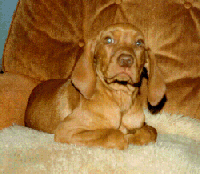



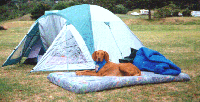
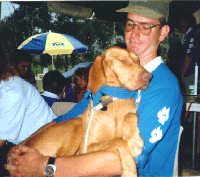
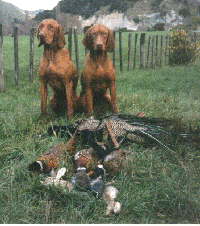


 The first principle in behaviour management is to focus on the behaviour you do want, not
the behaviour you don't want. This keeps training a positive experience.
The first principle in behaviour management is to focus on the behaviour you do want, not
the behaviour you don't want. This keeps training a positive experience.